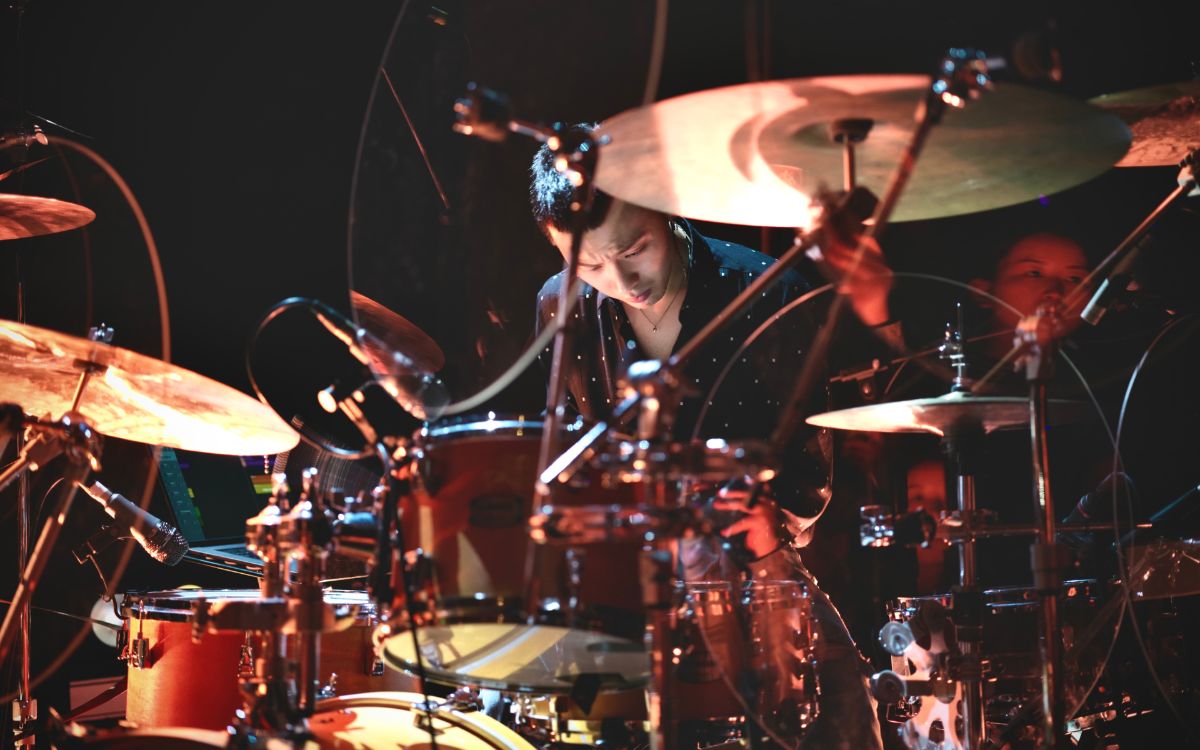Interestingly drums are one of the few instruments where most people don’t learn to play them by reading notes. However, reading drum sheet music is a wildly useful skill that can further your playing.
Here’s a comprehensive guide on everything related to drum sheet music. We’re going to look through how to read drum notes with lots of examples, and I’ll also give you some tips on improving your reading skills. Let’s get to it!
Contents
Drum Notation is Different from Other Sheet Music

Before getting to the basics, it’s important for you to understand that drumming has its own set of notes. While all melodic instruments have notes, scales, sharps, and flats, drum music sheets are completely different.
The good thing is that drum notation is arguably easier to read than melodic notation. In a music sheet for drums, you don’t need to worry about key signatures or accidentals. If you don’t know what those are, don’t worry about it.
You just need to know about subdivisions and drum note placements, which is what I’m going to explain as you read on.
Why Reading Notation is Important for Drummers
Many drummers wonder why they even need to learn how to read. I used to be the same, but I quickly realized how many opportunities opened up once I could read drumming notation.
The ability to read drum notation will help you learn new patterns and drumming techniques more quickly. It’s much easier to read a concept and repeat it over and over than it is to attempt to hear it and copy it.
Some drummers are gifted with natural listening abilities. Many are not, so reading is usually a better option, especially with more complex fills and grooves.
Having the ability to read will also allow you to write ideas down clearly and concisely. As drummers, we often forget how to play those cool licks that we just thought of. If you can write it down, you can play it later.
Lastly, being able to read opens up teaching opportunities. Drum teachers who can read are more attractive than ones that can’t, so reading has the potential to increase your income.
The Basics
There are a few basic concepts and layouts of sheet music that you need to know before you start reading. Think of these things as the structures that hold sheet music together. They give you direction and tell you what the limits are.
Staff
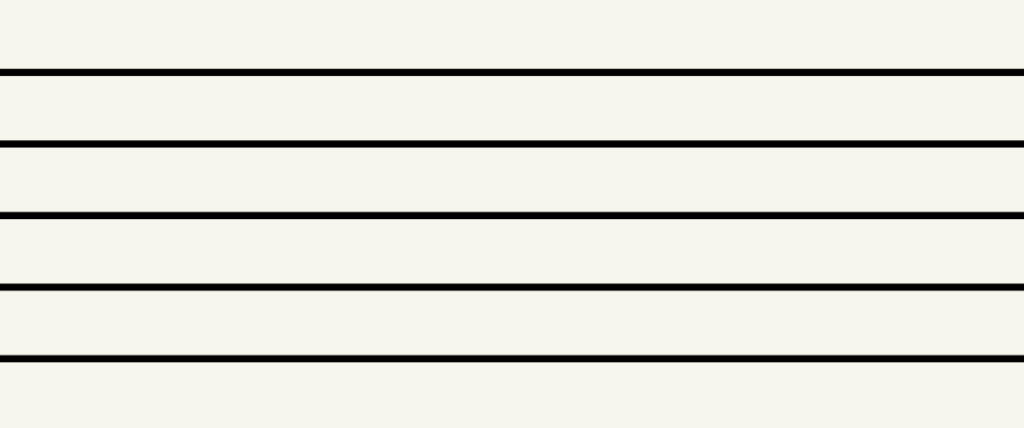
The first thing you’ll see is the staff. These five lines hold all the notes in all the bars, giving you a platform to read from.
Percussion Clef
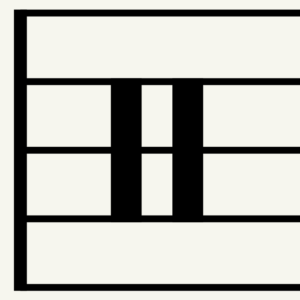
A clef tells you how the notes on the staff are described. Depending on what instrument you’re playing, the type of clef will change. When reading drum notes, you’ll see the percussion clef at the beginning of every staff line on a page. The percussion clef tells you that you’re going to be playing drum notes.
Time Signature
The time signature is the number that follows the percussion clef. The top number tells you how many beats there are in a bar. The bottom number tells you how fast or slow you’re going to count those beats.
That’s generally the easiest way of understanding time signatures. Luckily, most drum sheet music is in 4 over 4 time, so we’ll stick with that for now.
Notes and Placements

Every piece of your drum setup has a place on the staff. This is the most important thing to memorize when learning to read drum sheets as those notes will tell you which drums to play.
Here’s an image to show you where every drum and cymbal are placed on a bar. Take note, drum notation is somewhat fluid, meaning different people notate it differently sometimes. You’ll see a ride cymbal written on top of the line sometimes and beneath it other times.
Repeat Bars

Repeat bars are one of the most common things you’ll see in drum sheet music. Since drumming is repetitive, it’s way easier to show a repeat in a bar instead of writing the part over again. If you ever see this sign in a bar, it means you must repeat what you played in the previous one.
The repeat sign that has a 2 in it means you should repeat the previous two bars that you played.
Note Values
Make sure you understand all the fundamental layout rules before moving on to this next section. We’re now going to move on to note values, which are the main aspect of reading music sheets for drums.
Quarter Notes
Quarter notes are the most basic drum note when playing the drums. They’re also called crotchets. They hold one count. This means that when you play a quarter note, you count one count before moving to the next note.
If you were to write them out in one bar, it would look like this.

These are the easiest notes to work with as they’re fairly simple to get a grip of. Here are a few examples of quarter notes being played on the drums.
Quarter Note Example 1

Quarter Note Example 2

Quarter Note Example 3

Eighth Notes
Eighth notes hold half the count of a quarter note. They’re also commonly called quavers. You can tell it’s an eighth note whenever you see a tail on the stem of the note. When you have two eighth notes next to each other, their stems join to form a bridge.
Here’s what a single eighth note would look like, followed by two eighth notes joined together.
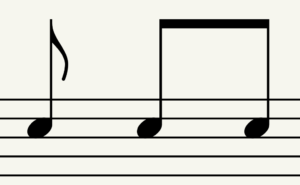
Here’s a group of them in a bar. You count eighth notes by saying “1 & 2 &” etc.
(Image 8)
Eighth notes are a lot more commonly played on the drums than quarter notes are. Here are a few examples of eighth notes being played on the drums.
Eighth Note Example 1

Eighth Note Example 2

Eighth Note Example 3

Sixteenth Notes
One sixteenth note has half the value of an eighth note and a quarter of the value of a quarter note. That may be confusing at first, so just think of sixteenth notes as the fast ones. Similar to eighth notes, they have tails. However, they have two tails instead of one, and the tails join when the notes are next to each other.
Sixteenth notes are counted “1 e & a 2 e & a” etc. Here’s a group of them in a bar.

You’ll notice that there were 16 notes in that bar, hence the name.
Here are some examples of sixteenth notes being played around the drums.
Sixteenth Note Example 1

Sixteenth Note Example 2

Sixteenth Note Example 3

Rhythm Pyramid
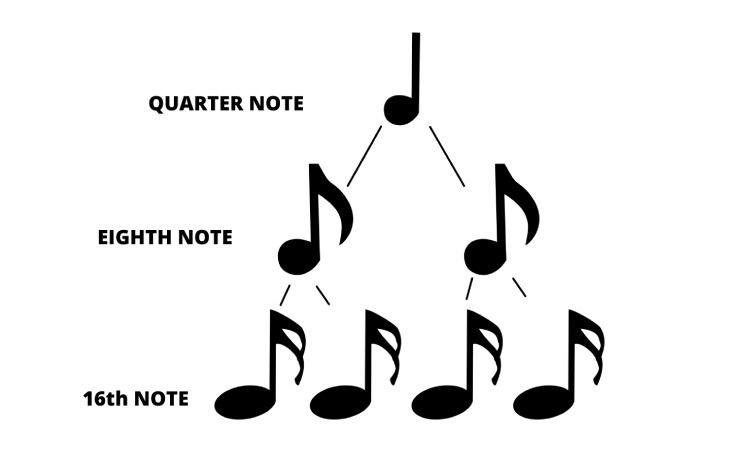
An easy way of understanding how note values work is to look at a rhythm pyramid. It shows you how many notes fit into each other, and then allows you to see how they would work in a bar. Rhythm pyramids typically start from whole notes which count for 4 counts, but you can’t play a whole note on the drums.
Quarter notes are typically where you start with drumming as you can’t sustain the sound of a drum. So, the adjusted rhythm pyramid here starts with a quarter note at the top. While looking at the image, you’ll be able to see that 2 eighth notes fit into a quarter note, and 4 sixteenth notes fit into the same quarter note.
Rests
Rests are signals that tell you not to play. They’re just as important as the actual notes, and each note has a related rest. A quarter note rest lasts one count, an eighth note rest last half a count, and a sixteenth note rest lasts a quarter of a count.
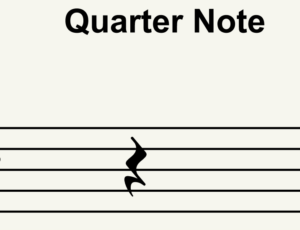
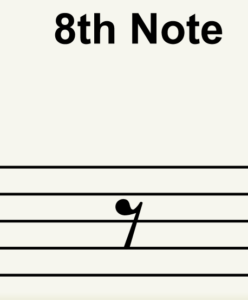

Here are some examples of what the rests would sound like on the drums.
Rest Example 1

Rest Example 2

Rest Example 3

Mixing Notes Together
Once you know how all the notes work together, you can’t start learning some grooves and fills on the drums. The easiest way to understand these grooves and fills is to look at the value of the notes and write the counting out above the bars.
Basic Beats
Basic beats are quite easy to read as you’ll typically be working with eighth notes most of the time. So, the counting will be “1 & 2 & 3 & 4 &” for these. The main trick will be figuring out where each drum is situated and playing that drum on the kit.
Beat 1
Beat 1 is a simple quarter-note groove. While it may seem easy to play, it’s important to be aware of the space in between the notes.

Beat 2
Beat 2 is your standard 8th note groove. It’s the most used drum beat in the world, fitting into thousands of songs.
Beat 3
Beat 3 is a 16th note groove. A groove like this is most often used in rock and hip-hop settings.

Basic Fills
Moving on to drum fills, these are typically a bit more difficult to read as you’re changing drums and rhythms more frequently. Here are a few examples that will increase a bit in difficulty.
Fill 1
This fill mixes 16th notes with a quarter note, creating a break in the fill that increases suspense.

Fill 2
Here you have a busy 16th note fill that drives the point forward with repetition.

Fill 3
This fill has the classic ‘two on the hands, two on the feet’ pattern that many drummers love.

Tips for Reading Drum Sheet Music
Count Out Loud
One of the best and fastest ways to get a grip on reading is to count out loud. If you write the counting out on top of every bar you see, you’ll be able to visualize the patterns and rhythms much easier. Counting out loud while drumming will also help with visualization.
The more you do this, the more natural reading will become, and you’ll eventually start to do it internally. Even pro drummers do it when learning complex drum parts. It’s important to do it slowly at first, and then speed up once you become comfortable.
Repetition
It goes without saying, but practice makes perfect. When reading drum sheet music, you’ll notice that there are groups of rhythms that you’ll come across very frequently. The more you see these rhythms, the easier they’ll become to recognize.
You’ll achieve this by repetition. Read some drum sheets over and over to internalize everything that is going on. Like drumming, reading is a skill that needs to be developed. It needs to be worked on and improved on.
Teach it to Someone Else
Another great way of improving your reading abilities is teaching them to someone else. Many drummers will tell you that their note reading skills skyrocketed once they started teaching.
It makes sense. You need to have a good understanding of something before sharing that knowledge with another person. Teaching someone else to read will also cause you to find the easiest ways of understanding drum sheet music.
Read as Much as You Can
One of the best ways to work on your reading is to find drum parts to read. The Internet is full of free resources where you can find songs that have been notated for the drums. If you work through those, you’ll see how quickly your reading ability will improve.
You’ll notice that most online drum lessons provide some sort of sheet music for you to follow. Checking those out and working on them is another great way to test your reading skills.
The Drumeo membership platform has over 3100+ songs with full notation provided for you to follow as you learn new songs.
Drumeo is an amazing platform with thousands of valuable lesson plans, as well as an enormous song library and an in-built app player that’s very intuitive to use with easy-to-follow notation to improve your reading and playing skills.

Another common thing to do is to read snare drum sheet music. Snare drum music will keep you purely focused on playing rhythms without worrying about all the components of a drum set.
Use Software
You should also be writing drum parts out yourself. Luckily, there are some free platforms that make it very easy to do this. One of the best ones is Groove Scribe. It allows you to write out drum parts without having extensive knowledge about note values. Instead, you just need to know about subdivisions.
The platform works as a fantastic learning tool as you can see how your ideas look when notated onto a drum sheet.
I also recommend Drumeo is an excellent educational drumming platform that offers not only thousands of lessons but also thousands of songs with notation and play-along functionality; so you can practice reading drum charts to your heart’s content!
Use PlayScore 2
PlayScore 2 is a useful app that can read sheet music and play it out loud. This means that you can use it to help you establish what certain drum notation parts sound like when you’re not entirely sure.
You can upload full scans to the app, and then it will play the parts out loud and give you the option of adjusting the tempo. This is brilliant for learning and understanding note values.
The app also lets you take pictures with an onboard camera. The picture function works surprisingly well.
With that said, there can often be a few mistaken notes with drum notation. The app seems to have perfected the function of reading melodic notes for various instruments, but there still needs to be a few updates regarding drum notation.
You’ll sometimes hear toms where there should be cymbals, or you’ll hear a cymbal where there should be a kick drum.
This shouldn’t stop you from using the app, though, as it’s mainly the rhythmic placements and spaces that it can help with. It’s quite easy to distinguish if a certain drum isn’t played in the right place.
I recommend keeping the app with you as you read pages on a music stand. When you practice and become unsure of a certain drum part, snap a picture through the app, and then you’ll be able to hear what the rhythms should sound like.
It’s not expensive either, making it an excellent option for most drummers on a budget. Unfortunately, it’s not available on Android devices just yet, but that’s sure to change in the near future.
Wrapping Up
Learning to read drum notation is one of the best things you can do as a drummer. It will open up so many opportunities for learning that you wouldn’t have if you couldn’t read. You’ll be able to learn things faster and easier. You’ll also be able to go through drum books to learn new material.
If you don’t know how to read drum sheet music, now is a better time than ever! The more you read, the better you’ll get.

